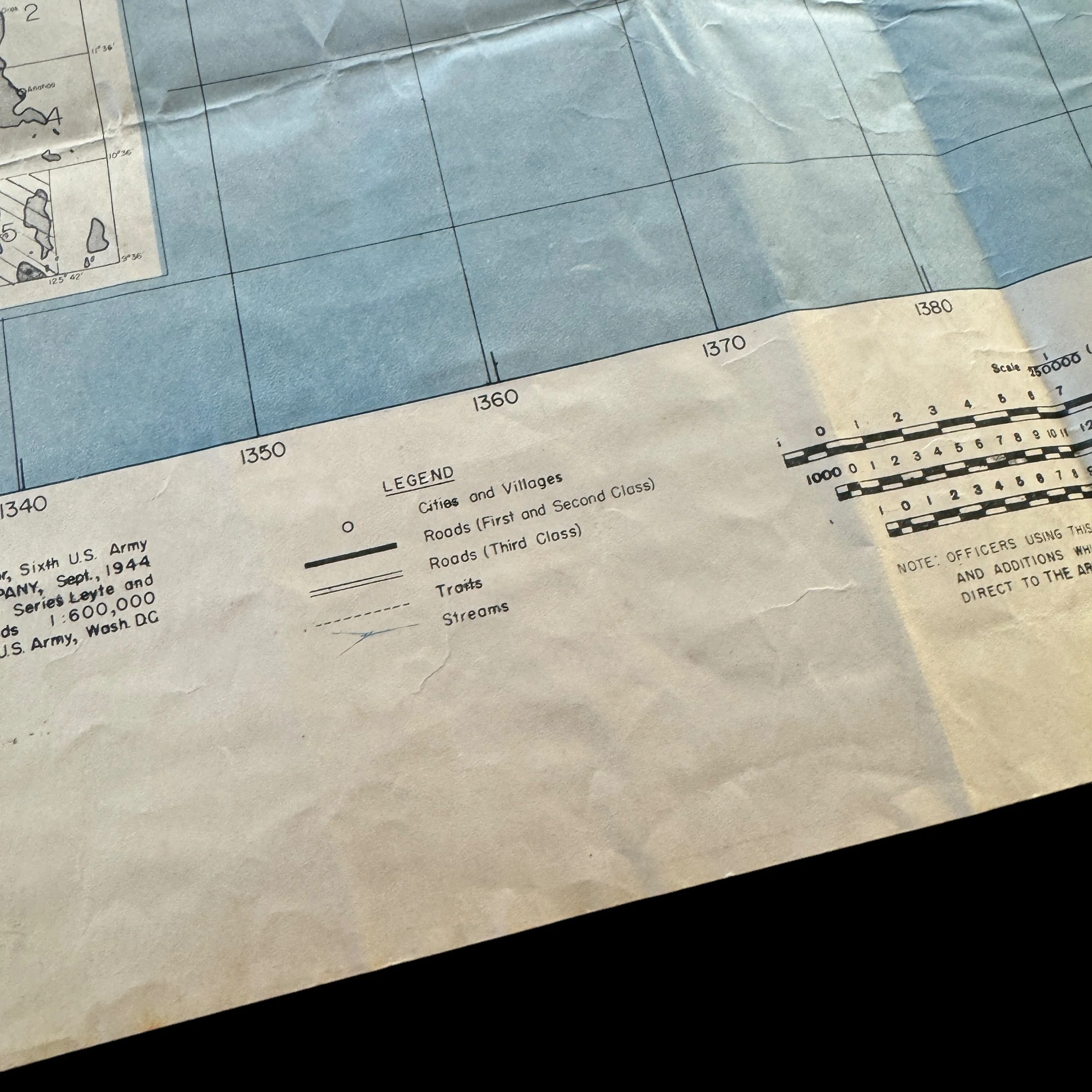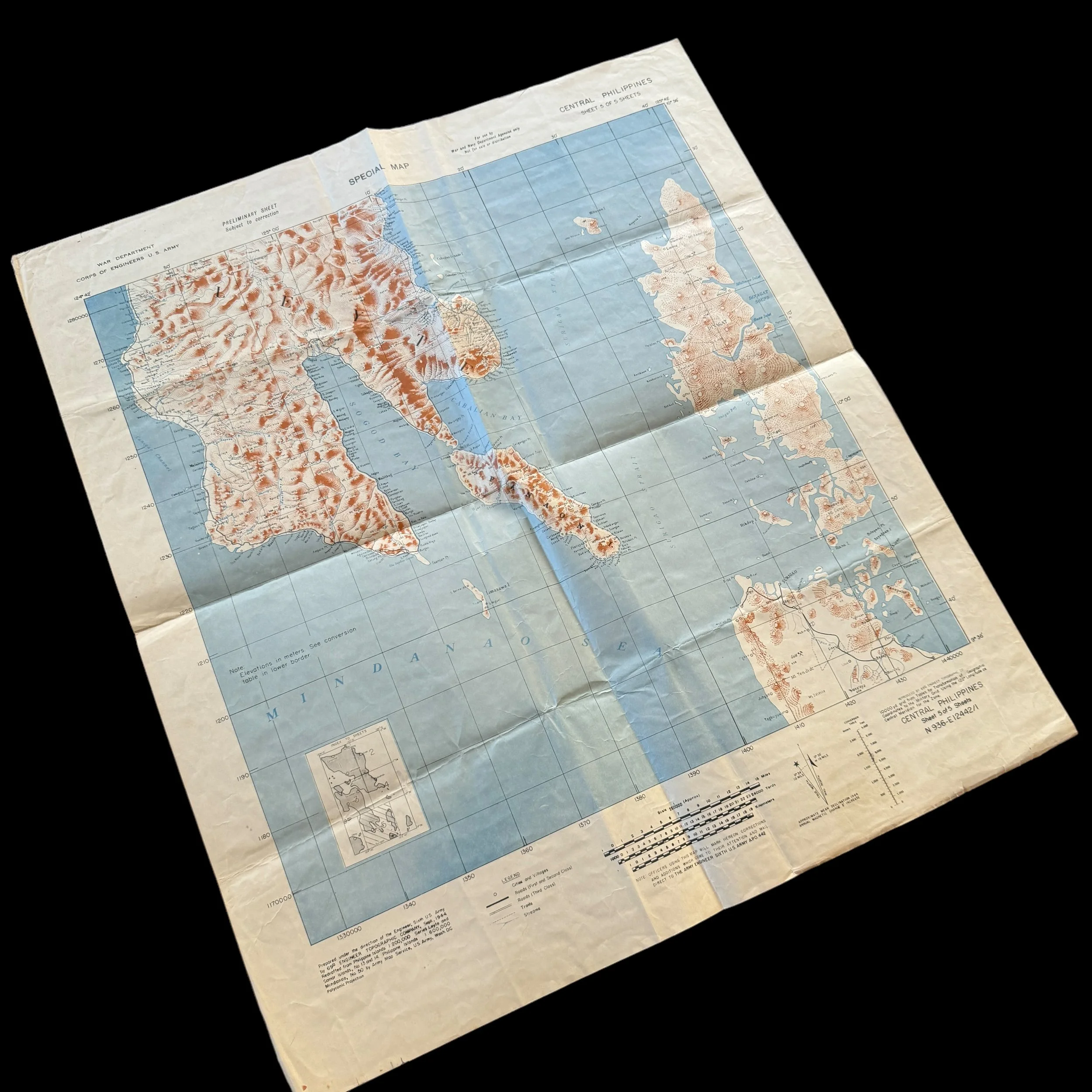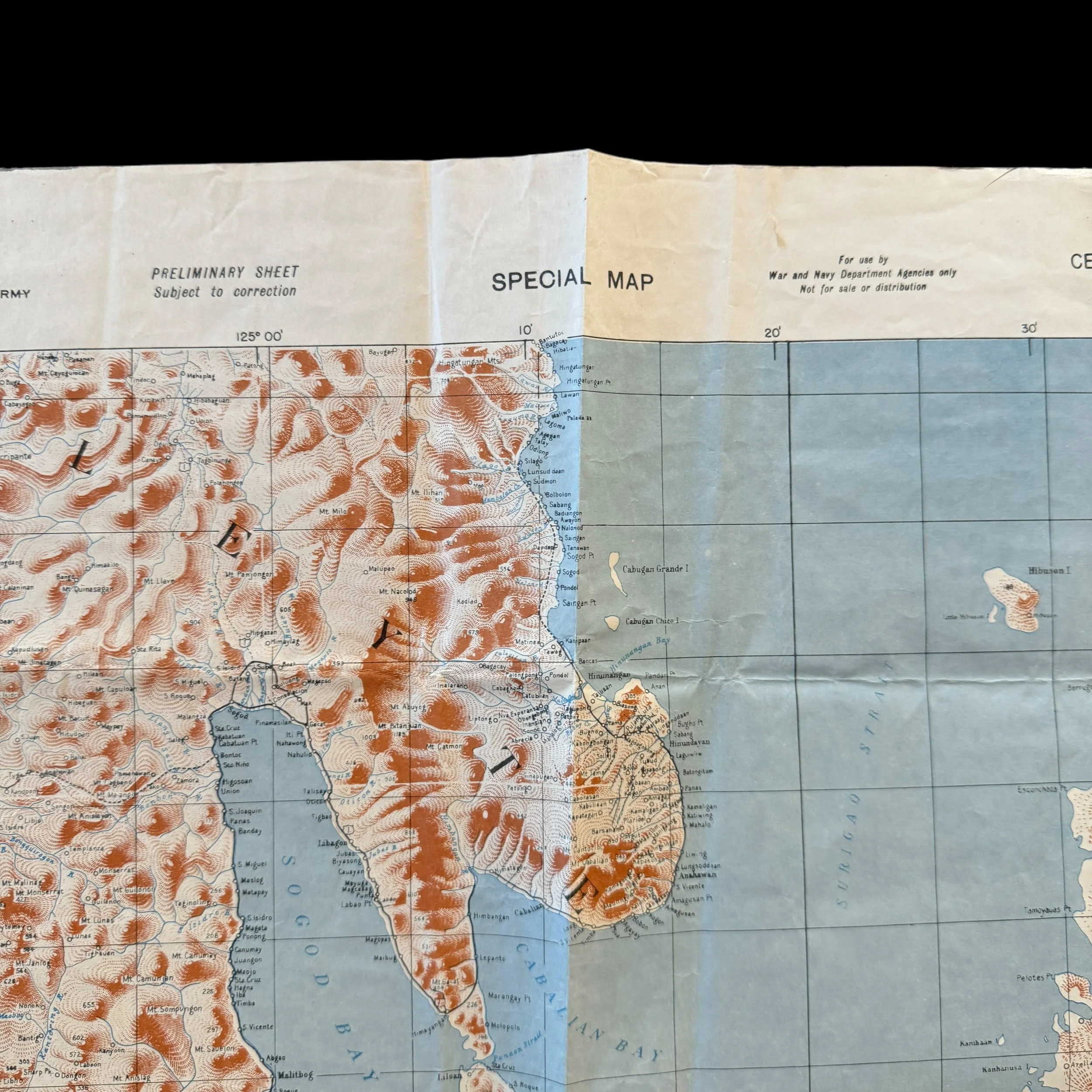RARE! WWII 1944 D-Day Invasion of Leyte Philippines Special U.S. INVASION MAP





























RARE! WWII 1944 D-Day Invasion of Leyte Philippines Special U.S. INVASION MAP
Comes with C.O.A.
Size: 19.5 x 22.5 inches
This incredibly rare and museum-grade invasion edition “SPECIAL MAP” is a very scarce first edition “PRELIMINARY SHEET” print of the Central Philippines. This preliminary print was printed before STAGE 1 of the initial Invasion of Leyte. This map was used during the Leyte combat operations for PHASE 1, PHASE 2, & PHASE 3 following the initial amphibious D-Day landings on October 20th, 1944 in the San Pedro Bay and lower Leyte Gulf.
The Invasion of Leyte, part of the broader campaign to liberate the Philippines from Japanese occupation during World War II, marked a pivotal moment in the Pacific theater. The invasion commenced on October 20, 1944, and continued until December 26, 1944. It involved a complex and coordinated effort by the Allied forces, primarily the United States, to reclaim the archipelago and significantly weaken Japanese control in the region.
The Philippines held immense strategic importance for both the Japanese and the Allies. For Japan, the islands were a critical component of their defensive perimeter and a vital source of raw materials. Control over the Philippines allowed Japan to threaten Allied supply lines and communication routes in the Pacific. Conversely, for the Allies, liberating the Philippines was essential for cutting Japanese supply lines, establishing bases for further operations in the Pacific, and fulfilling a moral obligation to free a country that had been an American commonwealth before the war.
General Douglas MacArthur, the Supreme Commander of Allied Forces in the Southwest Pacific Area, was particularly invested in the liberation of the Philippines. His famous declaration, "I shall return," after being forced to evacuate from the Philippines in 1942, underscored his commitment to retake the islands. The invasion of Leyte was the first major step in fulfilling that promise.
Planning and Preparation
The invasion, codenamed Operation King Two, involved meticulous planning and preparation. The Allies amassed a formidable force, including the U.S. Sixth Army under the command of Lieutenant General Walter Krueger, the Seventh Fleet under Vice Admiral Thomas C. Kinkaid, and elements of the Third Fleet under Admiral William F. Halsey Jr. The Japanese, anticipating an Allied assault, had also reinforced their positions, under the overall command of General Tomoyuki Yamashita.
The Allies aimed to secure Leyte as a staging ground for further operations in the Philippines. Leyte's central location, with its extensive coastlines and the presence of suitable landing beaches, made it an ideal initial target. The plan involved an amphibious assault on Leyte's eastern coast, followed by a drive inland to capture key locations, including the airfields and the provincial capital of Tacloban.
The Landings and Initial Assault
The invasion began on October 20, 1944, with an intense pre-invasion bombardment by naval and air forces. This bombardment was intended to weaken Japanese defenses and soften the landing zones. At 10:00 AM, American troops began landing on Leyte's beaches, facing relatively light resistance initially. General MacArthur made a dramatic return to Philippine soil, wading ashore at Red Beach near Palo, Leyte, symbolizing the start of the liberation campaign.
Despite the initial success, the Japanese quickly regrouped and launched counterattacks. The rugged terrain of Leyte, characterized by dense jungles, mountains, and rivers, posed significant challenges to the advancing Allied forces. The Japanese employed a strategy of attrition, utilizing guerrilla tactics and fortified positions to delay the Allied advance.
Battle of Leyte Gulf
A critical component of the Leyte campaign was the Battle of Leyte Gulf, which took place from October 23 to October 26, 1944. This naval battle, one of the largest in history, involved multiple engagements between the Japanese Combined Fleet and the U.S. Third and Seventh Fleets. The Japanese aimed to destroy the Allied invasion fleet and retake control of Leyte.
The Battle of Leyte Gulf consisted of several distinct encounters, including the Battle of the Sibuyan Sea, the Battle of Surigao Strait, the Battle off Samar, and the Battle off Cape Engaño. Despite initial successes in penetrating Allied defenses, the Japanese forces suffered devastating losses, including the sinking of several battleships, aircraft carriers, and cruisers. The battle effectively crippled the Japanese Navy, diminishing its capacity to conduct large-scale naval operations for the remainder of the war.
The Ground Campaign
Following the initial landings, the ground campaign on Leyte intensified. American forces faced fierce resistance from well-entrenched Japanese defenders. The struggle for control of key locations, such as the airfields at Tacloban and Dulag, proved particularly challenging. The Allies utilized their superior firepower, including artillery and air support, to overcome Japanese positions.
One of the most significant challenges was the Battle of Breakneck Ridge, a heavily fortified Japanese position in the central mountains of Leyte. The terrain and weather conditions made the assault particularly grueling, but after weeks of intense fighting, American forces managed to secure the ridge, significantly weakening Japanese defenses.
In addition to combat operations, the Allies also relied on the support of Filipino guerrilla fighters who provided invaluable intelligence, conducted sabotage operations, and assisted in the rescue of downed Allied pilots. Their contributions were instrumental in the success of the Leyte campaign.
The Aftermath and Significance
The successful invasion of Leyte marked a turning point in the Pacific War. It paved the way for subsequent Allied operations to liberate the rest of the Philippines, including the crucial battles for Luzon and Manila. The capture of Leyte disrupted Japanese supply lines and severely weakened their defensive capabilities in the region.
The Leyte campaign also had significant implications for the Japanese war effort. The loss of Leyte and the destruction of a substantial portion of the Japanese fleet during the Battle of Leyte Gulf marked the beginning of the end for Japanese control in the Pacific. It forced Japan to adopt increasingly desperate measures, including the widespread use of kamikaze attacks, which would become more prominent in subsequent battles.
For the Filipino people, the liberation of Leyte symbolized the beginning of the end of Japanese occupation and the restoration of their independence. General MacArthur's return to the Philippines and the subsequent victories of the Allied forces reignited hope and bolstered the resolve of the Filipino resistance movement.
The Invasion of Leyte stands as a testament to the strategic ingenuity, determination, and sacrifices of the Allied forces during World War II. It showcased the complexity and scale of amphibious operations, the importance of air and naval superiority, and the resilience of soldiers fighting in harsh and unfamiliar conditions. The campaign's success not only facilitated the liberation of the Philippines but also significantly contributed to the ultimate defeat of Japan in the Pacific War. The legacy of the Leyte invasion endures as a powerful reminder of the costs and consequences of war, as well as the enduring spirit of those who fought for freedom and justice.